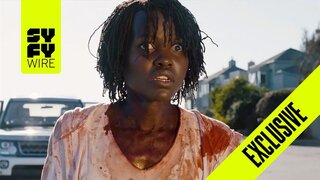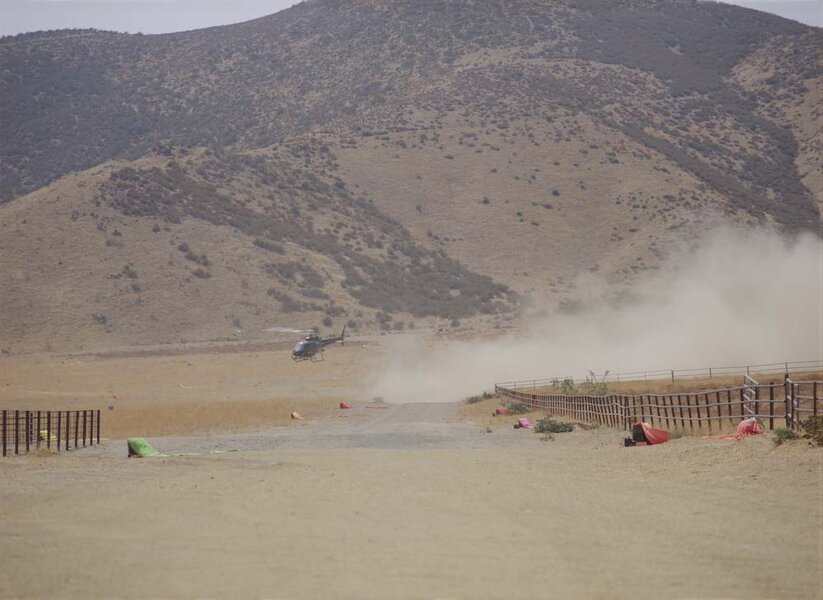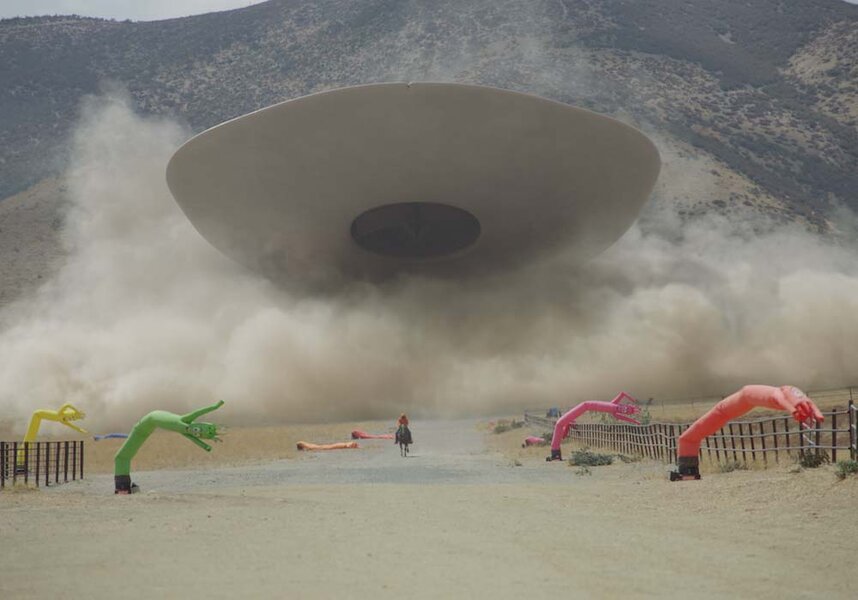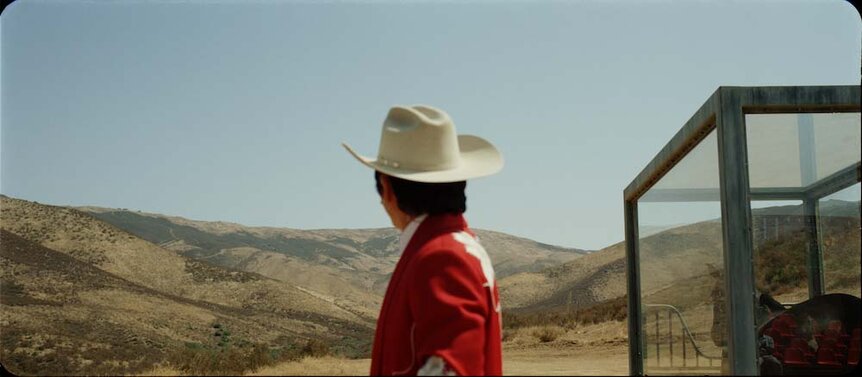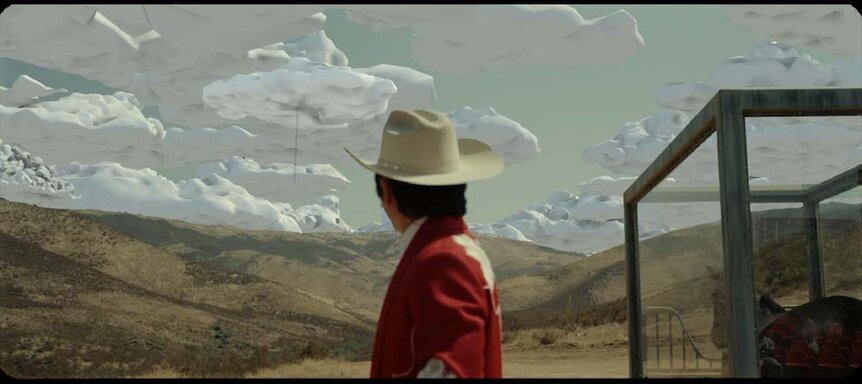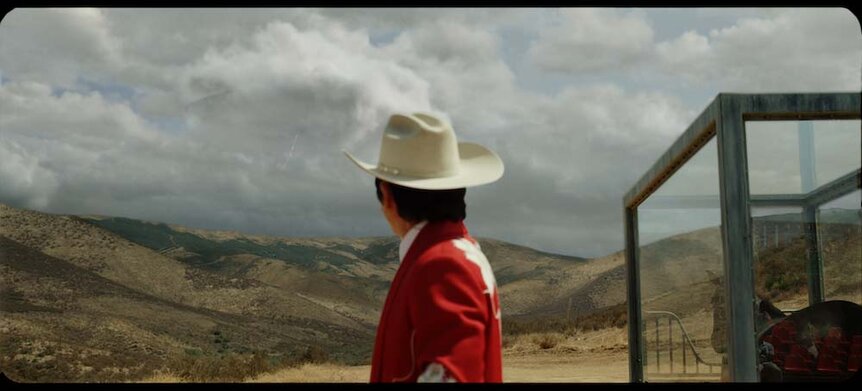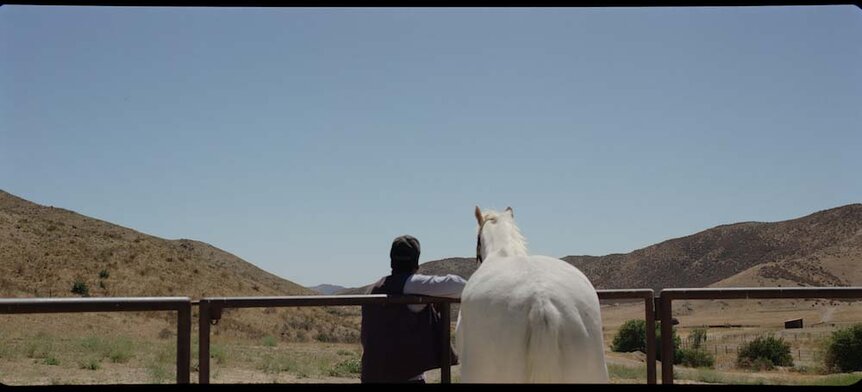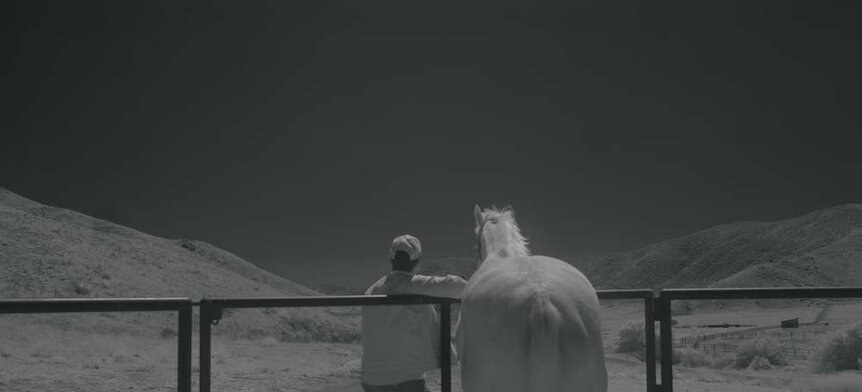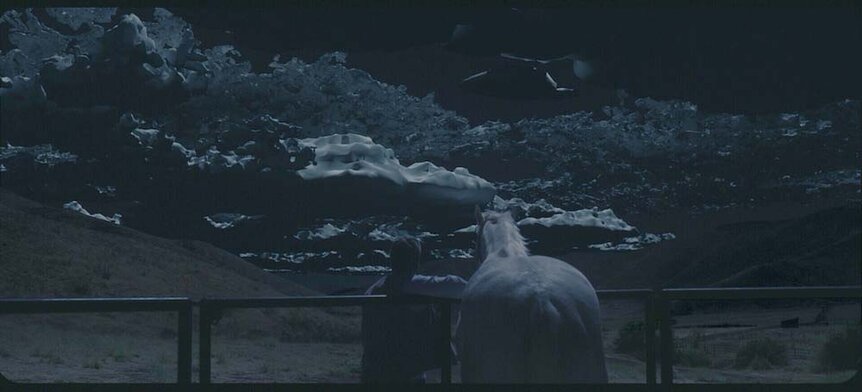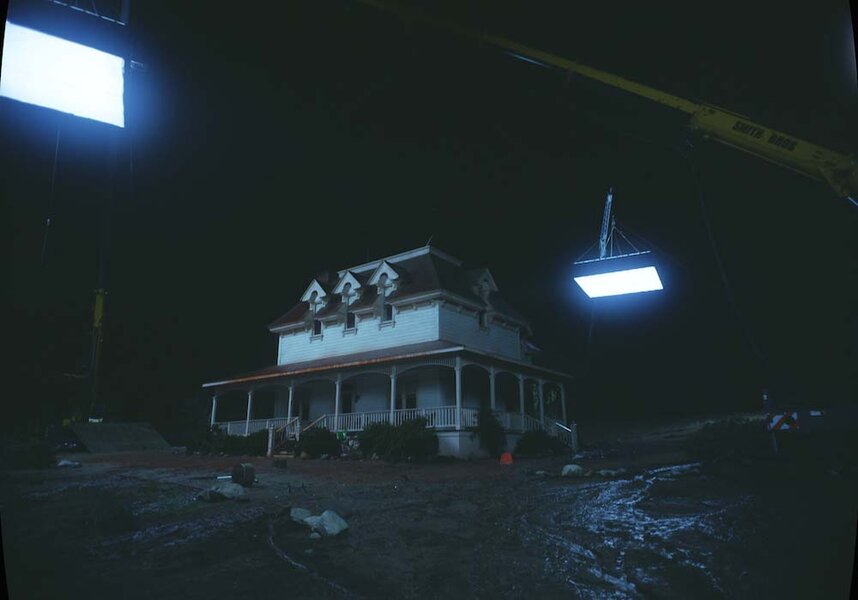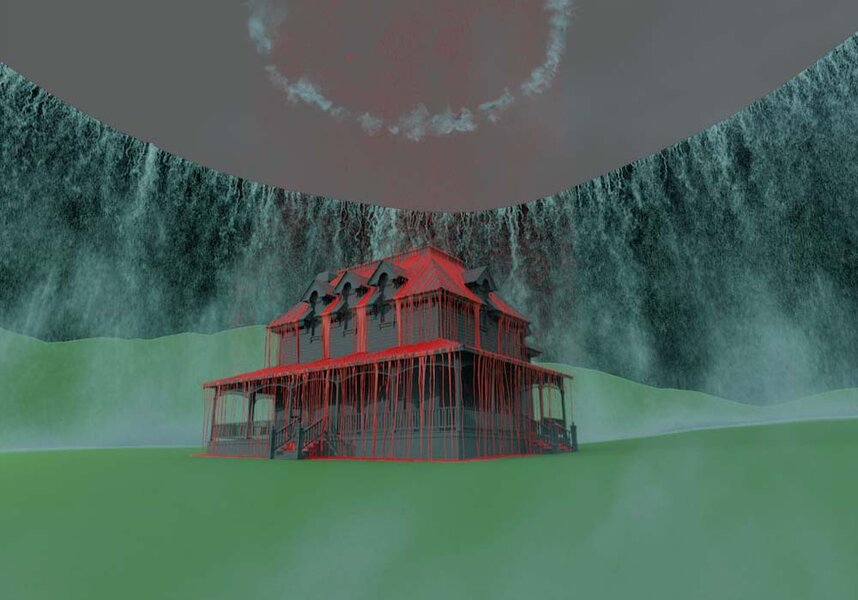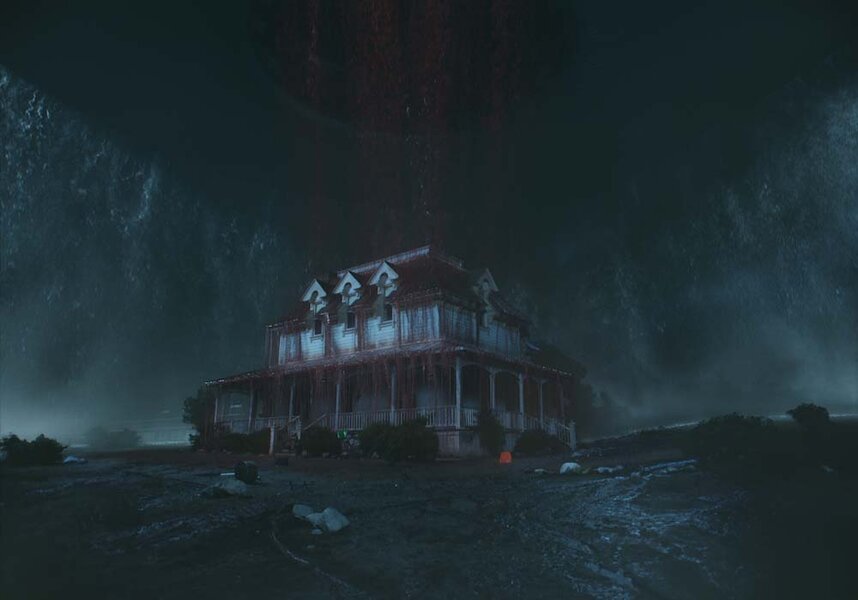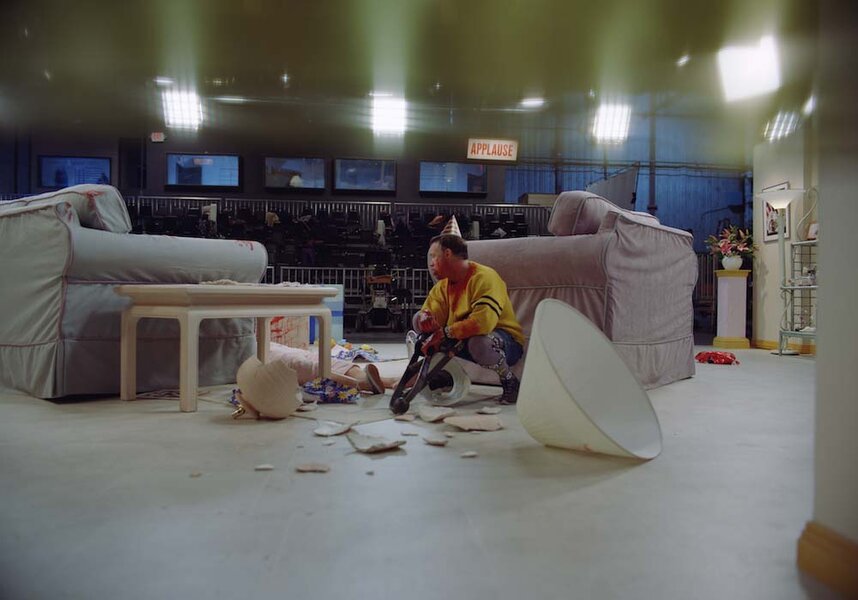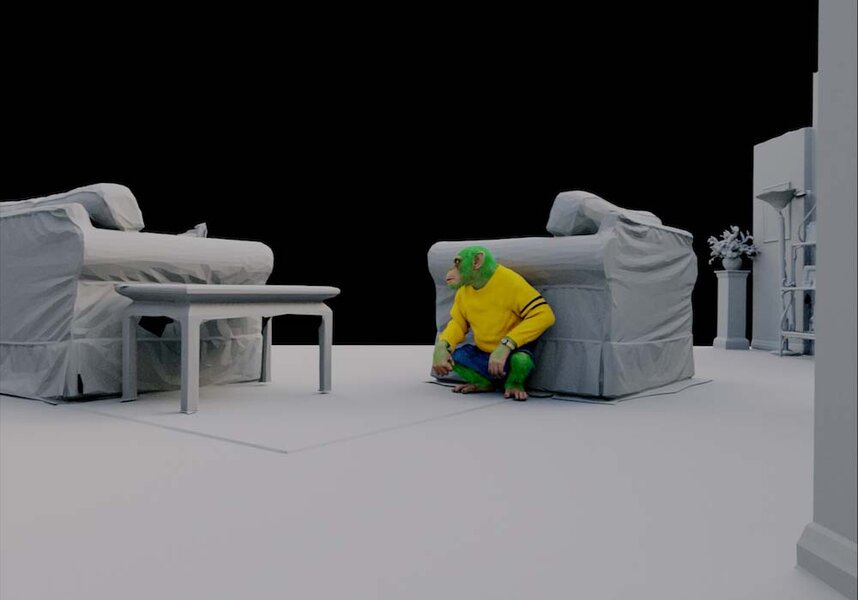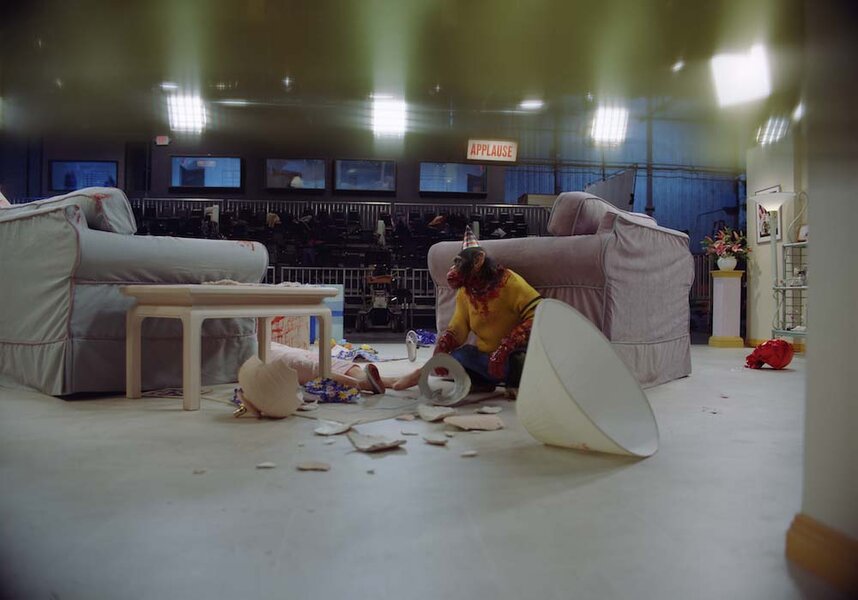Create a free profile to get unlimited access to exclusive videos, sweepstakes, and more!
Inside How Nope Invented Its Killer Creature & Literally Built a VFX Night Sky for The Big Bad
Nope is currently streaming on Peacock!
Pablo Picasso once said: "Learn the rules like a pro, so you can break them like an artist." That statement feels wholly applicable to Nope, which takes nearly a century of flying saucer imagery and chucks it right out the window. Jordan Peele's sci-fi/horror outing (now on Peacock) effectively upends everything we think we think we know about the alien invasion genre, providing a fresh twist on humanity's eons-old tradition of looking up at the night sky and wondering if there might be something else beyond our own existence.
But wondering can sometimes be a dangerous proposition. What if that foreign entity lurking amongst the clouds doesn't come in peace? What if the saucer we've seen a billion times in popular culture was just a massive stomach with a hunger for people and horses? What then?
While Nope certainly follows that concept to its bone-chilling conclusion, the film is more preoccupied with our perverted obsession with showy exhibitionism. The big screen UFOs of post-World War II were an obvious analogy for America's fear of the Soviet Union. Peele's contemporary interpretation of the same visual, on the other hand, critiques modern society's insatiable appetite for spectacle and how people are always trying to find ways to exploit it in exchange for a quick buck and 15 minutes of fame.
Who is the real monster here: the famished alien or our greedy, ego-driven species? That's up to the audience to decide as Emerald and OJ Haywood (Keke Palmer and Daniel Kaluuya) — the last-remaining vestiges of a Hollywood legacy that's becoming dimmer by the day — attempt to restore glory and financial prestige to their family name.
Jean Jacket
In order to wring fresh terror and social commentary out of a genre that's been thrilling audiences since the Martian Tripods first landed on Earth in the waning days of the 19th century, Peele needed an iconic movie monster; one whose design would not only break all the rules, but linger in the viewer's memory long after the credits had rolled. The Oscar-winning filmmaker behind Get Out and Us grasped this immediately, reaching out to VFX studio, MPC, while still in the process of writing the screenplay two years ago.
"I jumped in and connected with him and started to brainstorm a couple of ideas," Production VFX Supervisor Guillaume Rocheron tells SYFY WIRE over Zoom. "For the design, we talked a lot about movie references, nature references … a lot of things. Then we just got to work and started to iterate on the design of Jean Jacket. It was in August 2020 and we were still finishing work on that design three weeks before the movie came out."
For More on Jordan Peele:
Say "Yes" to the 5 Best Moments from Jordan Peele's Nope
Jordan Peele Launches Initiative to Find the Next Great Horror Filmmaker
Horror Fan's Critique of Jordan Peele's Us Goes Viral - Do You Agree With the Hot Take?
That two-year period of careful meticulousness was all in service of creating an entity "that was unique," he explains. "It's a creature of the wind and we wanted to find design codes that would be realistic and plausible, but, on the other hand, not be your typical creature. As we were starting to work on the design, we talked a lot about [everything from] the classic flying saucers to Neon Genesis Evangelion. That was a big inspiration for us. And then just looking at sea life like jellyfish and cuttlefish; studying nature and coming up with something that we felt could somehow be a real animal and not just something that would be scary just because we wanted to make it so."
Peele and his trusty VFX wizards never wanted to go overboard with too many bells and whistles in our current age of bloated CGI excess (a rather ironic philosophy, given the movie's subtext). "Very early on, we embraced something very minimalistic in terms of the design, where it was just like, ‘Okay, function and design work together,’" Rocheron says. "Which is very much the opposite of what you do on films today now that you have the ability to put as much detail as you want on the computer model."
He continues: "[Jordan] had a very clear idea on how to bring a spectacle to the audience in the context of the movie. [It came down to] restraint and really trying to capture a bit of movie magic … I grew up in the ‘80s and I grew up being fascinated by Jaws and Close Encounters and Jurassic Park. The movies where you're not watching action, it’s like a wonder. You just look at it and it’s like, ‘Oh, my God, I can't believe what I'm watching.’ It was a lot of the DNA of how we wanted the audience to experience the movie. You're so desensitized to spectacle in a way, [so] how do you give something that is fresh and not spectacle for the sake of spectacle? ... That was our trick, to obscure things and give the onus on the brain because this is how we remember growing up [and] how we get fascinated by things."
Consulting with scientists at the California Institute of Technology and NASA's Jet Propulsion Laboratory, the visual effects team found themselves digging further into the biology of jellyfish, researched extensively at Caltech by Professor John O. Dabiri. "We learned through him that the the jellyfish is basically the most efficient animal in the ocean," Rocheron adds. "It uses barely any energy to move, to eat; all its body parts and everything is very efficient. It rides water currents and uses very, very little energy to do so. It inspired us a lot: ‘Okay how do we do apply that to a wind creature and how do you make it efficient?’"
Despite the fact that the creature (given the official Latin classification of Occulonimbus edoequus by its scientific advisors) heavily evokes the sleek and otherworldly saucers found in old B-movies, Nope purposefully leaves its origin up to one's own interpretation. Like the shape-shifter in The Thing or the Xenmorph in the original Alien, this utter lack of neat backstory makes it that much scarier by tapping into our collective and never-ending fear of the unknown in the face of vast and apathetic cosmos.
"Even if you think about it as an alien, an alien is still an organism that has evolved through its own environment and through the same rules of evolution as us in a certain way," Rocheron says when we asked if a concrete explanation for Jean Jacket was ever discussed behind-the-scenes. "As much as you're trying to suspend disbelief in the audience and they’re just like, ‘Yep! I’m watching a flying saucer hunting of a bunch of horses and people,’ it's not normal. It's hiding in the clouds. But if you can somehow make it feel like, ‘Okay, it feels like a predator.’ You’ve seen videos of tiger and wolves hunting ... It's something that is plausible and realistic and it grounds you in it."
Where any other cinematic beast would probably require the development of intricate "muscle systems and skins shaders," the mysterious entity driving the plot of Nope was "made entirely [out] of simulating large pieces of cloth," Rocheron explains. "This is kind of how we approached it, the purpose of its skin is to harness the wind and ride it. So we just launched the biggest cloth simulations we've ever done."
The Cloudscape Conundrum
Getting the design right for Jean Jacket was only half the battle. In addition to building and fine-tuning the monster, MPC also had to figure out a way to control every aspect of the heavens above the lonely California desert town in which the movie unfolds.
Aside from two close-ups, every single shot involving sky (and by extension, the stationary clouds in which the Jean Jacket likes to hide) were completely digital. "We did a year of R&D to create a system that would allow us to construct cloudscapes like you would build the sets," Rocheron says. "Geometry where you move clouds around and you construct the pieces and place them where you need. Then you take them and you run them through large fluid simulations."
The biggest influence on the entity's natural environment, of course, was the Steven Spielberg classic that invented the modern day blockbuster. "Jordan said, ‘The skies are going to be some of the biggest challenge because this is the playground of the film,'" continues the VFX supervisor. "You want the audience to look at the sky and you want the audience to question what they’re going discover in there. And if we do our job well, you’re gonna look at the sky and you're going to be scared. It’s the same way you watch Jaws. You're not going to go for a swim right after seeing the movie, you're, looking at the ocean differently."
It's all the little details — ones that might have been negligible on another tentpole offering — that build up this atmosphere of realistic immersion. For example, a great deal of time and energy went into how clouds cast a shadow onto the ground below, "which is not something that we do in general because it doesn't matter, but it really mattered for this movie," states Rocheron, going on to explain that a number of practical tricks of the trade were employed wherever possible, especially for the scenes in which Jean Jacket hovers close to the ground to feed, kicking up dust and generating cyclones.
"Whether it's blood falling from the sky or debris or dust, we always try to capture something in-camera ... that we would then build up upon. When the entity is in its saucer form, it's 240-feet wide, so it's the size of an Airbus A380. It's massive and you don't realize the scale of it. So when you create dust interaction, you notice that there’s a lot of it. When we were filming, we had a helicopter that was literally there to act as a giant fan to move dust all around. We got dusted on for weeks and weeks of filming. I found dust in my pockets for like two months after we finished filming."
"I Wear My Sunglasses At Night"
What may surprise fans the most about Nope is the fact that almost none of the night scenes were actually filmed at night. "We shot in plain daylight in 100-degree heat of the Californian desert, which was a really interesting experience and a big leap of faith for us," Rocheron says. "But it allowed us to create those very immersive nights, which is really what we wanted. If you watch this on the big screen, suddenly you're gonna start to see the way you see at night and see the expanse of the sky. And by seeing the expanse of the sky, suddenly you feel like a little dot in the vastness of your environment. That starts to become very scary and very immersive and very interesting."
Hoping to avoid the pseudo-phony aesthetic of smoke and fabricated silhouettes — what Rocheron calls "movie nights" — director of photography Hoyte van Hoytema (Interstellar, Tenet) pushed the boundaries of cinematography by creating a special camera rig that would simulate the way through which the human eye behaves in the absence of light. The rig itself was comprised of a regular camera and an infrared camera with matching lenses and synchronized shutters. This process yielded two versions of the same footage — one in color and one in black and white.
"It's almost like when you colorize an old black and white movie, except that this time, we had the real colors, because we were filming it, not inventing them," explains the VFX supervisor. "So we knew the colors and then created a lot of processes and techniques to blend the two together ... Really create that [sense of] night that hopefully feels real, but not like it was shot on a [regular] camera. It’s real [in the way] you see at night. I think that was the fun of it and the immersion we were really trying to get for the whole film."
Stomach Trouble
Whenever Jean Jacket feeds, it must eventually regurgitate inorganic material that it cannot digest (coins, glasses, etc.). This aspect of its metabolism, which is established in the opening minutes, gives Peele an excuse to drench the Haywood household in a monsoon of blood shortly after the alien noshes on former child star Ricky "Jupe" Park (Steven Yeun) and his gathered audience of thrill-seeking spectators at Jupiter's Claim. It's an iconic and Kubrickian visual in the making that wouldn't feel out of place in a 19th century gothic horror novel. At first, the good folks at MPC ran "some tests to drop some large-scale blood on the house," but ultimately decided to use CG with a few practical flourishes.
"There's no way that you can build something that will do that at that scale," Rocheron admits. "It's impossible, so we simulated that giant, circular waterfall. And then the blood falling on the house, all that is simulated in CG." For tighter shots within the house, the special effects crew made use of prop blood and victim detritus. "We tried to mix and match the techniques all the time, so you’re always somehow grounded in reality. But yeah, it was a very large, CG blood simulation."
Gordy's Home
The rampaging chimpanzee in the '90s-era flashback was not an actual monkey, but a motion capture performance turned in by Terry Notary, who has lent his simian services to other blockbuster films like Kong: Skull Island, Rampage, and Rise of the Planet of the Apes.
"We wanted to do this scene differently in line with our philosophy of trying to keep our audience engaged. We didn't want to reveal the horror of the chimpanzee too clearly [or] too quickly," Rocheron recalls. The scene is showcased through the point-of-view of [young] Jupe who is under the table and there’s the semi-transparent silk tablecloth in front of it. We decided to showcase the whole scene through there until Gordy comes really close to camera and you start to see him very clearly. But it was quite a challenging thing to do because obviously, we had to create a photorealistic chimp [that was] incredibly detailed. When he comes close to the camera and you see him on an IMAX screen, it's literally like having like a real life-sized King Kong looking at a window. It's just incredibly big. But also showcasing it through the tablecloth really created some complication, because suddenly, all the lights get diffused through the fibers of the silk. The visibility of the chimp and the shadows created all sorts of really challenging integration issues. But it was a great device for us. I think the scene is very successful because there's a mystery to the horror that slowly reveals itself as Gordy is getting more and more threatening, and closer and closer to you."
In order to get the best performance out of their ape stand-in, the crew not only dressed Notary in full costume ("blood on his face, birthday hat, the sweater, everything"), they also constructed an oversized version of the Gordy's Home set. "Terry is human-size and chimpanzees are much smaller. So what we did is we built a set around Terry that was oversized, where everything was bigger. So when he was performing, it was literally as the size of a chimpanzee. So when he climbed on the sofa, the sofa was 30 percent bigger than normal, so you had to climb on it like a chimpanzee. We created that whole environment to really capture a performance that is as interactive as possible."
The VFX supervisor concludes: "We [also] surrounded the set with a lot of witness cameras, so our animators could see the performance from every angle, triangulate the position of everything, and then take Terry's performances and translate that into a chimp. That's where the animation work really starts. Chimpanzee faces behave differently, so it’s like, 'How do we animate Gordy [and] keep the soul of Terry’s performance, but [also keep it authentic]?' Chimpanzees can’t move their eyebrows too much, for example. There's just a lot of things that are slightly different that you need to integrate in terms of the performance. We had a great team of animators to do that and then we're simulating all the cloth and all the fur and all the blood to really make it as real and grounded and horrific as possible."
Nope is currently streaming on Peacock.
Originally published Sep 1, 2022.
